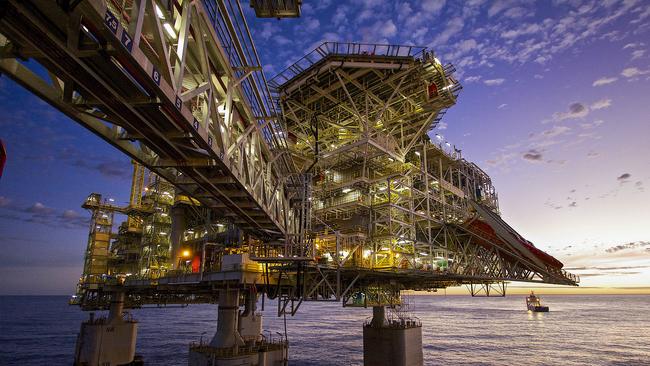Strikes at Chevron gas facilities in WA spark fears of energy crisis after negotiations crumble
Tense scenes are unfolding at sites of Australia’s biggest energy producers — sparking fears it could cause a global crisis that could spiral.
At Work
Don't miss out on the headlines from At Work. Followed categories will be added to My News.
The global gas market is “on a knife’s edge” as workers at two of Australia’s biggest liquefied natural gas (LNG) plants undertake increasingly disruptive strike action — with a union claiming Chevron has now been forced to “evacuate” workers from a rig.
Workers of Chevron’s Gorgon and Wheatstone projects – responsible for about 7 per cent of the world’s LNG supplies – in Western Australia started rolling protected industrial action on Friday after talks to avert the strike failed.
The actions from just a few hundred FIFO (fly in fly out) workers are causing tens of billions of dollars in market movements and sparking fears of a crisis.
News of the strikes spooked global markets, sending European natural gas prices soaring – they jumped a whopping 13 per cent when industrial action began on Friday.

Some 500 workers from the Offshore Alliance stopped work immediately for three hours last week, which will be extended to average about 10 hours a day this week. By September 14 there will be two weeks of 24-hour strikes, the union said.
The coalition of unions which represents Chevron’s workforce said the strikes would “escalate each week until Chevron agrees to our bargaining claims”.
It wants to see the energy giant address issues of pay, job security, rosters, transfers to other Chevron work sites, training standards and travel arrangements.
Within 24 hours of the strikes starting, Chevron reportedly started “evacuating” its contractor workers from its Gorgon LNG facility off the coast of the WA Pilbara region.
Chevron has rejected the use of the term “evacuation” — saying the removal of workers from the site was part of a normal relocation process
“Chevron chartered a special flight this morning to Barrow Island to evacuate 50 blue and white collar contract crew off the Gorgon Project,” Offshore Alliance said in a statement to Facebook.

“Chevron have now sabotaged their own maintenance program as a result of their actions.”
The post said members were “bunkering down for a long dispute” and warned the US LNG giant to “get used to the idea” of losing billions of dollars of export revenue “in their ideological battle against their own workforce”.
“OA members on the Gorgon and Wheatstone facilities will go one day longer and one day stronger than Chevron,” the statement read.
Chevron, however, rejected the union claims, instead some told The West Australian that operators had to focus activities and resources that will maintain production during potential disruptions.
One spokesman reportedly told the paper that the flight had been sent to return workers who had been in Perth for failed peace talks.
Chevron is reportedly seeking to follow the lead of Woodside Energy, which struck a deal with unions at its North West Shelf platforms to avoid industrial action after a 15-hour bargaining session, according to The Australian.
But relations between the parties have become so fraught that the Fair Work Commission has been called in to settle the deal for them.
On Monday, Chevron announced it saw “no reasonable prospect of agreement” with the unions and would opt for an “intractable bargaining” declaration which, if granted, would end strikes and allow the Commission to dictate an agreement for them.

“Unfortunately, following numerous meetings and conciliation sessions with the Fair Work Commission, no agreement has been reached as the unions are asking for terms significantly above the market,” a Chevron spokesman said in a statement, Reuters reports.
The case will be a watershed test of new laws introduced in June, which empower the Commission to force parties into an agreement if and when they reach a stalemate.
A first hearing is scheduled for Tuesday afternoon in Melbourne.
Action stokes fears of energy crisis
Amid the tense industrial relations battle, there are fears of an energy crisis spiralling out of control.
This is because, Australia is the world’s biggest LNG exporter and its main buyers are in Asia. Chevron’s two facilities are responsible for about half of Western Australia’s domestic gas supply.

Energy analyst Saul Kavonic told The Australian that the unions and Chevron were about to engage in “a lot of tactical positioning” to test the “legal and political limits” of the industrial action.
Mr Kavonic said negotiations between Chevron and the unions have been “a bit different” than the Woodside Energy negotiations.
“There’s been far less progress being made, and I think Chevron’s taking a less flexible – let’s call it a more American approach to union negotiations,” he told Sky News Australia.
“This is actually something which is going to create a lot of inefficiency in the operations and also as it drags out could impact production.”
He said gas traders in Europe “are on a knife’s edge” due to the ongoing effects of Russia cutting off gas supply as it wages war against Ukraine.
“There’s no redundancy left in the global gas market and that’s why gas traders in Europe are so jumpy here,” Mr Kavonic said.
“Yet, it’s quite remarkable that a few hundred FIFO (fly in fly out) workers in overalls are causing tens of billions of dollars in market movements.”
More Coverage
Originally published as Strikes at Chevron gas facilities in WA spark fears of energy crisis after negotiations crumble




